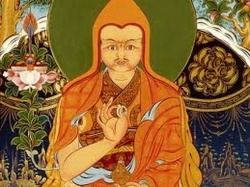Religion Buddhism Period in office 17th century | ||
 | ||
Other names Drakpa Gyeltsen (གྲགས་པ་རྒྱལ་མཚན།), Zimkhang Gongma Drakpa Gyeltsen (གཟིམས་ཁང་གོང་མ་༤་གྲགས་པ་རྒྱལ་མཚན), Trülku Drakpa Gyeltsen (སྤྲུལ་སྐུ་གྲགས་པ་རྒྱལ་མཚན།), Kyorlung Ngari Trülku 06 (སྐྱོར་ལུང་མངའ་རིས་སྤྲུལ་སྐུ་༦). Other name Drakpa Gyeltsen (གྲགས་པ་རྒྱལ་མཚན།), Zimkhang Gongma Drakpa Gyeltsen (གཟིམས་ཁང་གོང་མ་༤་གྲགས་པ་རྒྱལ་མཚན), Trülku Drakpa Gyeltsen (སྤྲུལ་སྐུ་གྲགས་པ་རྒྱལ་མཚན།), Kyorlung Ngari Trülku 06 (སྐྱོར་ལུང་མངའ་རིས་སྤྲུལ་སྐུ་༦). | ||
Trülku Drakpa Gyeltsen (1619–1656) was an important Gelugpa lama and a contemporary of the 5th Dalai Lama (1617–1682). His Seat was the upper residence (Wylie: gzims khang gong ma) of Drepung Monastery, a famous Gelug gompa located near Lhasa.
Contents
Incarnation lineage
Tibetan Buddhists consider Trülku Drakpa Gyeltsen to be the 6th Kyorlung Ngari Tulku, a line of incarnate lamas which began with Duldzin Dragpa Gyaltsen (1374-1434), an important disciple of Je Tsongkhapa, the founder of the Gelug school.
Tulku Dragpa Gyaltsen is also called the 4th Drepung Zimkhang Gongma or rebirth of Panchen Sonam Dragpa, the 3rd Kyorlung Ngari Tulku, who held the posts of the 15th Ganden Tripa and abbot of Drepung. Before his death in 1554, he had established his own monastic estate, known as the Upper Chamber (Zimkhang Gongma), named for its location at the top of Drepung Monastery just below the Ngakpa debating courtyard. This grew to be a rival centre of power in Drepung to the estate of the Dalai Lamas, called Ganden Phodrang, or so-called lower chamber (Zimkhang 'Ogma) which had been constructed in 1518 by the 2nd Dalai Lama.
According to Lindsay G. McCune, the "Gelukpa authorities" agreed that Tulku Dragpa Gyaltsen was the immediate rebirth of Sönam Gelek Pelzang (1594–1615), and the fourth incarnation, or tulku, in the Drepung Zimkhang Gongma line.
Prior births
His prior "incarnation lineage" includes:
Some Tibetan Buddhists believe that, prior to his birth as Duldzin Dragpa Gyaltsen, he was also Buton Rinchen Drub (1291–1364) of Shalu Monastery
Subsequent rebirths
Tibetan historian Samten Karmay writes that after the death of Dragpa Gyaltsen the search for his reincarnation was banned. Thus the Drepung Zimkhang Gongma line ended and the estate founded by Panchen Sönam Dragpa in 1554 at the Upper Chamber of Drepung ceased to exist in 1656.
Some believe that Tulku Dragpa Gyaltsen then appeared as the wrathful deity Dorje Shugden. However at that time Tulku Dragpa Gyaltsen's own students and supporters disagreed with this account, stating that this spirit was not that of Drakpa Gyeltsen but rather that of the Fifth Dalai Lama’s minister Desi Sönam Chöpel (sde srid bsod nams chos ’phel; 1595-1658), who was an enemy of Drakpa Gyeltsen and who had also died around the same time. Georges Dreyfus also notes that "there are other stories that seem to hint that the evil spirit connected with Drak-ba Gyel-tsen was already active prior to the latter's demise, even as early 1636. If Shuk-den was already active prior to Trul-ku Drak-ba Gyel-tsen's tragic demise, how can he be the latter's wrathful manifestation?"
The Tibetan Buddhist Resource Center database lists a continuing line of Kyorlung Ngari tulkus subsequent to Tulku Dragpa Gyaltsen:
Rivalry, murder and reincarnation
Tibetan historian Samten Karmay writes "It should be recalled that he had been one of the candidates for the reincarnation of the Fifth Dalai Lama. As a result, he was always seen as a rival of the Fifth Dalai Lama though he invariably proclaimed himself a disciple of the latter. He came to be despised by a number of officials and especially the sDe-srid."
Samten Karmay further writes "The circumstances of his death, whether natural or not, were contested and part of the dGe-lugs-pa school believed that the official Norbu, acting under the sDe-srid's orders had assassinated him. Whatever the truth, the search for his reincarnation was banned, which suggests that the affair must have been quite serious indeed. In 1658, the actual building of the 'Upper Chamber' was destroyed and the stupa containing the remains of the Lama was supposedly thrown into the sKyid-chu river. It was then believed that the spirit of Grags-pa rgyal-mtshan had returned as a sort of 'protector of the Buddhist religion'."
